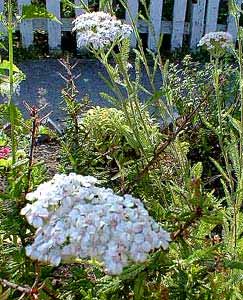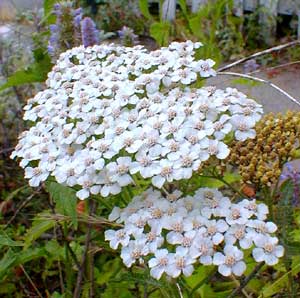
'White Beauty'
Mountain Yarrow
"Or let us trace this streamlet to its source;
Feebly it tinkles with an earthy sound,
And a few steps may bring us to the spot
Where, haply, crowned with flowerets & green herbs,
The mountain infant to the sun comes forth,
Like human life from darkness."
-William Wordsworth
(1770-1850)
(1770-1850)
Yarrows (Achillea millefolium) come in so many colors. The most common wild color is pink, but natural races of bright yellow & pure white are also common, & by hybridization & re-hybridization, growers have produced an ever-increasing array of colors. The breeding programs have included both intraspecies hybrids to enhance color variations, & cross-species hybrids that bring in traits from other Achillea species.
The subspecies or variant A. millefolium occidentalis (aka A. millefolium ssp lanulosa var alpicola or A. lanulosa) is commonly called Mountain Yarrow, though it grows in lowlands as well as in mountains at mid levels. This is the true North American native that dominates the hybrid history of our purest white garden yarrows. It has several color phases throughout its large range, but pure white is widespread in the West & Northwest.
It is sometimes called Wooly Yarrow, because its alternate taxonomic designation A. lanulosa means "wooly," & its white flowers do invoke the wool of bighorn sheep which share the mountainsides with these yarrows, the bighorns being among the few ruminants that actually likes to eat bitter yarrow.
 White Mountain Yarrow as a true native of North America was described during the Lewis & Clark expedition, on 20 May 1806, in Idaho. It sometimes called "Western Yarrow" because it is found throughout the American west, British Columbia, & Alaska.
White Mountain Yarrow as a true native of North America was described during the Lewis & Clark expedition, on 20 May 1806, in Idaho. It sometimes called "Western Yarrow" because it is found throughout the American west, British Columbia, & Alaska.It does range also across Canada & the midwest & much of the east coast, so "Western Yarrow" is somewhat a misnomer.
Though gardened white yarrow is commonly marketed as 'White Beauty,' it is doubtful this name represents a single strain. Any really pleasant white may end up sold under this name.
Even the wild populations have been hybridized with introduced variants or subspecies, & because its range is so broad, it exists in many color strains from white to pink to purple, though white is especially common from California mountains to Oregon's coastal sand dunes.
It is a clumping perennial that is only about a foot tall but with wider rhizomic spread. It is perhaps marginally less hardy than the usual Eurasian strains, but all things being relative, it is extremely hardy. In two & a half years in a very harsh often dry location, our one white clump hasn't spread as much as the yellow 'Moonshine' Yarrow & 'Lavender Beauty' clumps, though it has spread considerably more than a 'Paprika' red clump, all growing in the same general vicinity around the base of a laurel-like evergreen Strawberry Tree.
An unusually long period of nonstop deluge in winter/early spring 2008/2009 caused some of the many yarrows in this location to rot out of the ground, & after years of pleasant delights, 'White Beauty' was gone, though I plan to replant it anew & have already replanted some of the others, though in a more raised area in case we have another non-stop deluge.
In ideal conditions yarrow clumps can be expected to spread two feet in two years, filling in all the space provided to them. But this grouping had beem been put in very hard ground kept dry by the root system of the strawberry, where the ground could never be worked for them before small starts were inserted into small holes. Hence these yarrows were a bit stunted compared to others we have in better soil away from any trees or large bushes. Even so, stunted ones still bloom fabulously, & really fill the bill in a spot that would cause most perennials to shrivel right up & disappear.
Propagation is easiest by division of clumps that have spread to over a foot round, best done in spring or autumn. The 'White Beauty' clump could never be divided, however, because it was not possible to dig a large enough area around the strawberry tree without damaging roots. At best I might've dug out a small piece to start over in a new location (at almost any time of the year), or start a new plant from a basal cutting in spring.
Propagation can also be affected by planting seeds or by self-seeding, but gardened yarrows are so hybridized they almost never grow true from seed.
The other yarrows can start flowering as early as May, certainly by June, & last through summer. But for us 'White Beauty' was the last of the yarrows to be in full bloom, having its first major flush of flower in late July, then reflowering well into autumn.
Each flat-headed bloom is made up of clusters of tiny flowers over sea-green foliage. On Puget Sound it likes full sun; further south or inland it might like a tiny bit of shade, lest the flowers fade prematurely. It prefers soil that is neither too rich nor too wet. Yarrows are very appealing to butterflies, but disliked by deer. They are useful in bouquets whether fresh or dried.
The folkname Sneezeweed is not as commonly used as the names Yarrow & Milfoil, but arose because people with allergies commonly respond to yarrows. It can also be a contact allergen, the plant's juices causing itchiness for people with sensitive skin. I've never noticed any such responses myself, though I do occasionally get the sneezes when in the garden, & never know which if any plant caused it.
Continue to:
'Lavender Deb' Yarrow